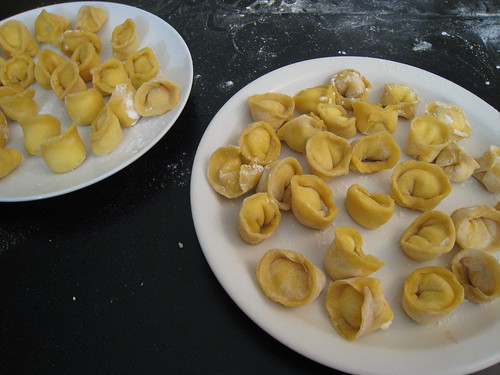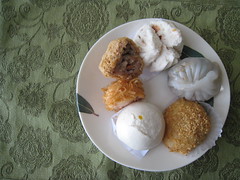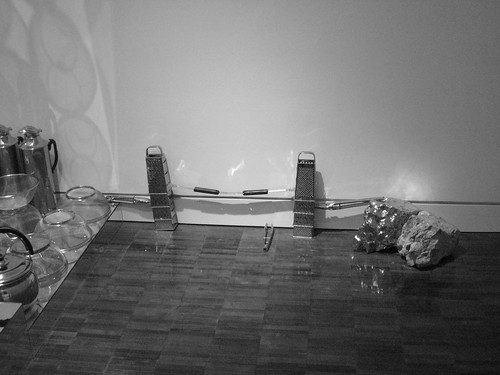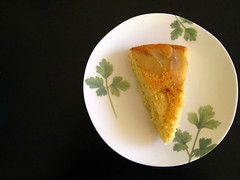
Gevalt. My shoulders hurt, my back hurts. My triceps are no longer on speaking terms with me, and they’re whispering mutiny to the biceps. Yesterday, I made my own dumplings out of hand-rolled dough without the use of a pasta machine. Now I know what it must have felt like to be a housewife in a 19th century shtetl. All I need is a washboard for the laundry and a roof for my husband to fiddle on as he sings “TRADITION! TRADITION!”
I know, I know. It sounds like hyperbole. But try it, you’ll see what I mean. Making the dough is fun at first. It involves mixing some beaten eggs into a mound of flour with a fork. At a certain point, you dispense with the fork altogether and use your hands. The joy of messiness, the kneading… it’s an adult version of play dough. After letting the dough rest, the rolling begins. If you’ve rolled your own pie crust, you may not think much of this part. Ah, but pasta dough must be thin, thin, thin—like paper, like silk. When you’ve been rolling a while and realize that your dough is still thick as pie dough, you begin to wonder how much longer. You throw yourself into it, using your weight to apply more pressure on the dough. You sweat through your t-shirt. You think “holy cannoli! What was I thinking?” Just when you decide to settle for
thick, lumpy kreplach, you roll just a little longer until the sheet of pasta is smooth and thin as it can get.
But you’re not done yet. You have to cut little circles with an upside down glass, being careful to place the circles as close together as possible so as not to waste too much dough. Then each circle must be brushed with water, filled with filling, and pressed closed. The pressing is an art in itself. The filling can’t be too much or too little, so that it fills the dough just enough without poking out the sides. The edges must be pressed together carefully around the filling without any air bubbles. Then the edges must be brought together, one side brushed with water, and pressed together firmly as though the dumpling is wringing its hands in front of its plump belly. But the dough must be soft and pliable enough that the belly doesn’t burst, spewing its cheesy contents. It’s painstaking work, alternately exasperating and meditative. But the result is that much more luxurious and tasty when you’ve worked so hard to make it yourself.
If you’re short on time and patience for hard labor, you could run your dough through a pasta machine. It’s probably best to run it through the highest to the lowest setting for a really thin, silky dough. You could use one of those plastic ravioli pressing gadgets that works like a waffle iron
, if you don’t feel like pressing the dumplings yourself. You could press the dumplings like kreplach (triangular wontons), or pelmeni (Russian tortellini). I gravitated towards tortellini style dumplings, as I thought they might better keep their shape and hold their filling (those wringing hands tend to hold the stuffing). But traditional kreplach triangles might be easier to make and certainly less time-consuming. (I’ve always felt that the triangular tips of kreplach or wontons are like delicate little pasta fins, the dumplings quietly swimming in your soup.)
I stuffed my kreplach with a cheese filling in honor of Shavuoth, the Jewish festival of the ten commandments. It is traditional to prepare all manner of dairy foods for this holiday, unlike most holidays where meat and fish are the festive foods. Jewish lore has it that the Israelites did not know how to keep kosher, as they hadn’t yet received the ten commandments. So they ate only dairy foods so as not to eat any animals that weren’t sanctioned by the law. (How did they know the law would prohibit the consumption of certain creatures? Good point. But again, this is lore…)
Back in Russia and Poland, Jews would prepare cheese kreplach served with fried onions or a dusting of sugar, sometimes sour cream or perhaps a bit of jam. The name, size and shape of the dumplings might vary depending on the region. I’ve prepared mine with a filling of goat cheese and za’atar, putting a Mediterranean twist on the Eastern European dish. As for toppings, I’ve used fried onions, leftover goat cheese instead of sour cream and plum jam. Yes, all three. The combination of flavors works surprisingly well.
Other traditional ways to serve kreplach include frying them with onions, or boiling them and then serving them in soup. Kreplach can be stuffed with potatoes, beef, chicken liver, or a combination of beef and pork if you want to make Ukrainian pelmeni (a non-Jewish cousin of the traditional kreple). You could alternatively make a sort of kreplach lasagne, layering sheets of fresh pasta with filling and toppings. How do you like your kreplach?
cheese kreplach for shavuoth
for the filling:
10 oz. soft goat cheese (chevre), or other cheese of similar consistency
5 stalks fresh za’atar, or other fresh herb such as dill, parsley, chives, oregano
salt and white pepper to taste
1 small egg
for the dough (adapted from a recipe in the NY Times):
1 3/4 cup all purpose flour
2 large eggs
lukewarm water, if necessary
for the topping:
goat cheese or sour cream or smetana
1-2 diced onions
butter
good plum jam (should be a little loose—I used June Taylor’s Elephant Heart plum conserve)
Preparing the filling:
- In a large bowl, crumble in the cheese.
- Hold the top of a stalk of za’atar with the thumb and forefinger of one hand. With the thumb and forefinger of the other hand, gently slide your fingers down the stalk, catching the leaves as they fall. Repeat for the remaining stalks. (This works for oregano as well, but any of the other herbs should simply be finely chopped.)
- Rip or chop the za’atar and throw it into the bowl of cheese.
- Season to taste with salt and white pepper. Taste and correct seasoning. Add a beaten egg and stir to combine.
Making the dough:
- On a large, clean flat surface (a wooden table would be good), make a hill of flour. Form a well in the center of the hill.
- Beat the eggs lightly and pour them into the well. Begin mixing the flour into the eggs with a fork.
- At some point, you’ll want to use your hands to mix the egg and flour. If the mixture appears dry, add a little lukewarm water (say 1 or 2 tablespoons). My dough was moist with just the egg.
- Knead the dough well, then let sit covered with a bowl or plastic wrap for 30 minutes.
Rolling the dough:
- Separate the dough into two parts, leaving one portion under the bowl. Take the other half and begin to flatten and stretch it a bit with your hands.
- Flour your surface and start rolling. You can use a pasta machine for this part. Roll the dough into an oblong shape rather than a circle. Be sure to move your dough frequently so that it doesn’t stick to the surface. Flour your surface just enough to keep the dough from sticking. You can patch any holes or cracks.
- Roll until you can’t roll anymore, and then roll a bit more. You want to get your dough as thin and smooth as possible. Remember, the pasta will absorb water and expand when cooked. Feel the thickness of your dough and try to imagine what it might taste like when cooked. If it tastes like a mouthful of dough, you need to keep rolling.
- When finished rolling, you might want to sprinkle a little water on the dough if it looks a bit dry.
Cutting the dough:
- Use a glass with a 3 inch diameter to cut circles of dough. Use a dull knife to help cut the dough if necessary. Try to minimize the space between each circle of dough so as to avoid excess scrap dough.
- When finished cutting the circles, collect the scraps and mush them into a ball. Place the ball under the bowl of resting dough.
Filling and shaping the dumplings:
- With a barely damp pastry brush, brush one circle with a little water, mostly around the edges.
- Place about a teaspoon of filling in the center of the circle.
- Bring one end of the dough over the other in a half circle sandwich of dough and filling. Use your fingers to press the edges of the dough from one edge of the semi-circle to the other, while gently smoothing out any air bubbles along the edge of the filling. Dance your fingers along the edges again to get a good seal.
- You can stop here, or you can continue folding the edges tortellini style. To do this:
- Brush a little water on one tip of the semi-circle.
- Then gently wrap the tips over your forefinger, the wet tip under the dry one.
- Use your thumb to squeeze the tips against your forefinger, sealing them together.
- Remove your forefinger, and gently squish the tips the other way (vertically).
- Place the dumpling on a lightly floured plate. (I used two plates for my dumplings, simply to avoid the hassle of stacking them on top of each other, in case they stuck.)
- Repeat for the remaining dough circles.
- Take out the second piece of dough and follow the rolling, cutting, filling and shaping instructions. You can ball up and roll out the scraps too, or slice them into jagged, randomly shaped noodles. These can be cooked briefly before boiling the kreplach. Drain and slather with butter for snacking on while the kreplach cook.
Cooking the dumplings:
- In a large skillet, melt some butter and fry the chopped onions on a medium to low flame until golden brown.
- Boil heavily salted water for the dumplings. When the water is boiling gently, tip the plates of dumplings into the pot.
- Agitate the pot lightly so that the dumplings don’t stick to the bottom of the pot. Cook until the kreplach float to the top.
- Remove the kreplach with a slotted spoon, draining the water.
- Top with fried onions, cheese or sour cream, and finally plum jam.
Serves 2-4
I picked up some great pasta making techniques from a class given by the inimitable Omnivorous Fish. Useful links here and here.











